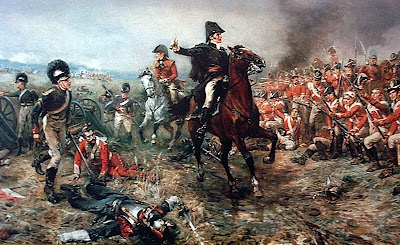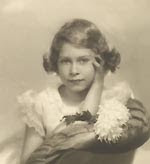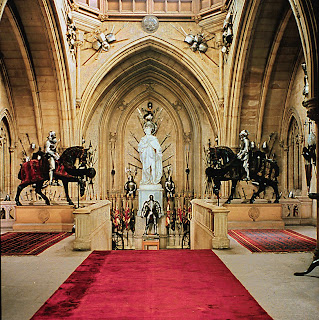Remember the situation in March, 1815. The victorious Allies were still carving up the map and dancing their hearts out at the Congress of Vienna. When they learned of Napoleon’s escape from Elba and his intention to re-establish his empire, the Allies designated four armies to prevent this. One was British and Belgian-Dutch with some German elements, commanded by Wellington, pictured above.
After Napoleon’s first abdication, much of the cream of the British forces had been sent to America to fight in what became known as the War of 1812, but actually continued until after the Peace Treaty was signed in December 1814. The Battle of New Orleans, which took the life of the Duke of Wellington’s brother-in-law General Sir Edward ‘Ned’ Pakenham (1778 – 1815) and hundreds of others on both sides, did not occur until January 8, 1815, beause news of the Treaty had not reached America. Drawing: Death of Pakenham

After he reached Paris, Napoleon’s plan was to march north from the French border to Brussels, defeating the Allied troops stationed around Brussels led by Wellington and the Prussian troops who were moving west from Germany toward a rendezvous with Wellington. Napoleon planned to prevent that meeting by keeping the two Allied armies apart. The plan of Wellington and Blücher was to meet up and defeat the French forces. At right, Prussian Field Marshall Gebhard Leberecht von Blücher.
The first battle was Quatre Bras (pronounced something like Ka-tra-BRA, meaning Four Arms), a strategic crossroads village. The road from the French border north to Brussels here crosses the east-west road from Germany to the coastal ports. At left, Quatre Bras today.
The English arrived here on the morning of June 16 and met French forces sent by Napoleon and led by Marshal Ney. As more and more Allied troops arrived, Wellington was able to hold off the French.

Meanwhile, at Ligny, near Fleurus in present day Belgium, the Prussian forces were beaten by the French. Right, the battlefield at Ligny where the Prussians were defeated.

Above, the monument at Fleurus honors three French victories. The 1815 victory at the nearby village of Ligny over the Prussians was the final victory of Napoleon’s career on June 16, 1815. Two days later, so to speak, he met his Waterloo!

Another sign at Quatre Bras. On the next day, Saturday, June 17, 1815, Wellington and his troops withdrew, fighting off the French, to the north. Blücher had moved his army to Wavre, north of their defeat at Ligny. Wellington wanted to stay even with Blücher so they could join up
to fight the French with their combined forces.

Several monuments to the Prussians are found around the area.
Below is the courtyard of La Belle Alliance, where Blücher and Wellington met after the battle on the evening of Sunday, June 18, 1815. They agreed that the Prussians should chase the fleeing French back to the border and into France. Meanwhile, Wellington would rest his troops for a day or so before joining in the pursuit. For most of the day, the British-Netherlands-Hanoverian troops had held out against the French until the Prussians arrived on the Western flank of the battle. At this point the British troops drove back the French Imperial Guard and it was soon a rout.
above two pictures, La Belle Alliance
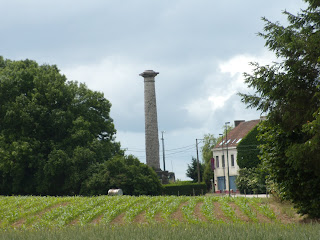
The nearby Victor Hugo Monument. There are many insightful accounts of what happened at Waterloo. Hugo’s is NOT one of them. I guess Hugo (1802–1885) found it difficult to believe that Napoleon was defeated. He wrote, “Waterloo! Waterloo! Waterloo! Morne plaine!” which translates as “Waterloo! Waterloo! Waterloo! Dismal plain!”
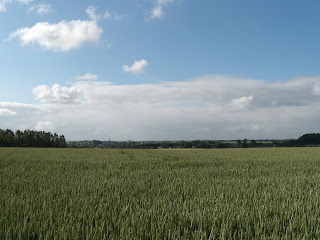
This is our first view of the Waterloo battlefield. As you can see, the day was sunny and bright, but that didn’t last. It was just the opposite 195 years ago. It poured rain all night and left both armies cold, wet, and hungry. Wellington’s troops were drawn up looking in the direction of this picture. Napoleon’s army was on the opposite side of the valley to the south.
All morning the Allies waited for the attack, but the French were waiting for the ground to dry out a bit. The mud made it almost impossible to move cannons, but the weather improved a little by the opening salvo about 11:30 am.

This is the famous Lion Mount, a memorial to the Prince of Orange on the spot where he was wounded. It was created from 10 million cubic feet of earth, scraped from the battlefield. The Prince was a sort of second-in-command to Wellington, but most British historians feel he was too young and inexperienced to have contributed much.
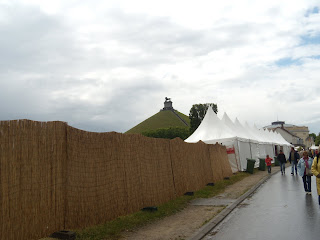
When the Duke of Wellington saw the Lion Mound (constructed from 1824-26), he complained, “They have ruined my battlefield.” In this view, we were walking toward the cafes, visitor’s center, panorama and the Lion Mound, which is also near the tree under which Wellington directed most of the battle.

As you can see, by our second and longer visit to the actual battlefield, it had darkened up with rainclouds. In another blog, we cover our visit to the encampment of the French re-enactors at Caillou, the small farmhouse in which Napoleon spent the night of June 17-18.
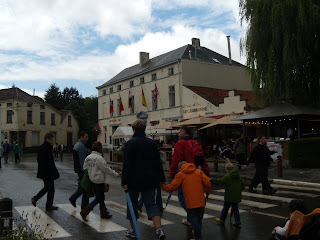
Here we all are trying to duck out of the rain at the site of the Battlefield Welcome center, Panorama, and cluster of restaurants. Wonder if the Zebra Crossing would have helped or hindered Wellington’s operations.

The actual village of Waterloo is a few miles north. The building in which Wellington spent the night before the battle and in which he wrote most of his Waterloo dispatch afterwards is now a museum. Right, more views of the restaurants, etc. at the battlefield.

In the souvenir shop, at least they had a copy of the book in English, but it was rather begrudging
about Wellington’s victory over Napoleon. Must have been translated from the French!

Kristine is entirely annoyed at the lack of Wellington memorabilia — Napoleon (the loser) on the other hand, was everywhere. Busts, action figures, key chains, tee shirts, you name it, Napoleon’s face was on it. Bah, we said. Remember who won.

We had to take shelter from occasional showers in these tents set up for text panels explaining the battle, but there were so many people crowded in them we could not read them in any sort of reasonable order.

This sign reads, in four languages (German, French, English and Flemish): “The French cavalry charges. Welcome to the site of the famous Battle of Waterloo. This is the place where, on Sunday 18 June 1815, nearly 180,000 men confronted each other for over ten hours with more than 35,000 horses and with 500 cannons firing. We are on the site of the main English line of defence, established by the Duke of Wellington, over more than 3 km. Starting at 16.00 and coming from the south, it was mainly here that seven or eight charges of more than 8,000 French cavalrymen, led by Marshal Ney, poured through for two hours under the fire of the allied infantrymen without nonetheless succeeding in breaking the English defence squares. Each of these squares consisted of around 600 men, in three ranks, shoulder to shoulder, and all pointing their muskets and bayonets toward the outside.”
Like most of the postings around Waterloo, it doesn’t actually say the Allied forces won and the French lost, does it?

Saturday afternoon, under threatening skies, we walked diagonally across the final section of the battlefield in the waving wheat. I am sure the horses and marching columns of men mowed it down quite effectively on Sunday.

People risked life and limb to get the best shot!
Above and below, the current state of the remnants of the sunken road that ran alongside the battleground and caused trouble for the French cavalry.

The Hussars conduct reconnaissance of the battlefield on Saturday. The weather was no better on Sunday, the day of the actual reenactment. But at least it was, in some part, historically accurate.
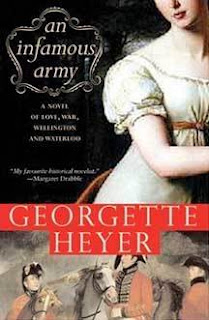
Here are a couple of suggestions for further reading on the Battle of Waterloo. If you are a fiction fan, the account in Georgette Heyer’s novel
An Infamous Army was once used as a text at the British military college Sandhurst.
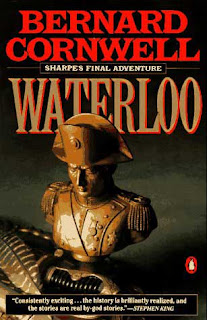
The final Sharpe adventure is excellent, and the account of the battle is reasonably accurate if you remove Sharpe from the action, in a sense.
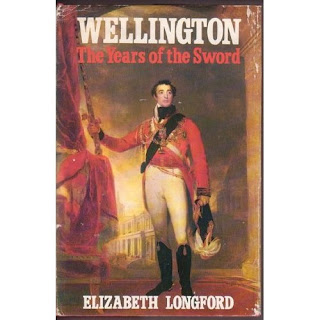
The late Elizabeth Longford wrote a two-volume biography of the Duke of Wellington. In the first of these, The Years of the Sword, there is an excellent account of the battle.

Of course there are hundreds of books about the Battle of Waterloo, the Peninsular Wars, the Napoleonic Wars, the Congress of Vienna, etc. etc. as well as websites, blogs and films. I haven’t fnished it yet, but I also recommend the book by the expert who accompanied our Waterloo visit, Jeremy Black of the Univerity of Exeter, UK.
To conclude, here is the painting of Waterloo after the battle by Joseph Mallord William Turner RA (1775–1851). It hangs in the Tate Britain in London and portrays the horrors of the aftermath, the wounded and dying men and horses, the mud, the searching and grieving friends and relatives, the scavengers, the essential darkness.















